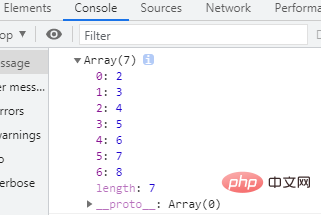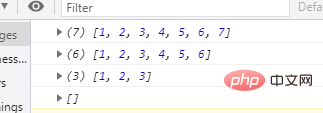JS array learning how to remove head or tail elements
In the previous article "JS array learning: How to insert elements at the head or tail? 》, we introduced the method of adding elements at the beginning and end of the array. Now that you know how to add elements, you also need to know the corresponding deletion operations. Today we will learn how to use JS to remove elements from the head or tail of an array.
First let’s take a lookHow to delete the elements at the head of the array?
In JavaScript, we can use the shift() function to delete elements at the beginning of an array. array.shift()The function can delete the first element of the array and return the value of the first element; then shift all remaining elements forward by 1 position to fill the vacancy at the head of the array .
Let’s take a closer look at the following example:
var a = [1,2,3,4,5,6,7,8]; //定义数组 a.shift(); console.log(a);
The output result is:

It can be seen that: the above example uses a .shift() to delete the value 1 at the beginning of the array a, and then reset the index (starting from 0 again); and the shift() method will change the original array and modify the length of the array! Therefore, use console.log(a) to output the original array, which displays the array whose first element has been deleted.
We know how to delete the elements at the head of the array. Next, let’s see How to delete the elements at the tail of the array?
There are many ways to delete the tail elements of the array. Here we will introduce two methods: one is to use the pop() method; the other is to use the length attribute.
1. Use the pop() method----you can delete an element at the end of the array
array.pop()method can delete it The last element in the array and returns the deleted element.
Let’s take a closer look at the following example:
var a = [1,2,3,4,5,6,7,8]; //定义数组 a.pop(); console.log(a)
The output result is:

It can be seen that the above example uses a.pop() to delete the value 8 at the end of the a array, and then reset the index (starting from 0 again); and the pop() method will also change the original array and modify the length of the array!
2. Use the length attribute - you can delete one or more elements at the end of the array (or even clear the array)
The length attribute of the array is generally used To set or return the number of elements in the array, that is, to set or return the array length.
We can take advantage of the feature of setting the length of the array and set the length attribute to be smaller than the original length to delete one or more elements from the end of the array; if the value is set to 0, the entire array will be deleted. That is, clear the array!
Let’s take a closer look at the following example:
var a = [1,2,3,4,5,6,7,8]; //定义数组 a.length=7; console.log(a) var a = [1,2,3,4,5,6,7,8]; //定义数组 a.length=6; console.log(a) var a = [1,2,3,4,5,6,7,8]; //定义数组 a.length=3; console.log(a) var a = [1,2,3,4,5,6,7,8]; //定义数组 a.length=0; console.log(a)
The output result is:

Okay, that’s it. , if necessary, you can read: javascript advanced tutorial
The above is the detailed content of JS array learning how to remove head or tail elements. For more information, please follow other related articles on the PHP Chinese website!

Hot AI Tools

Undresser.AI Undress
AI-powered app for creating realistic nude photos

AI Clothes Remover
Online AI tool for removing clothes from photos.

Undress AI Tool
Undress images for free

Clothoff.io
AI clothes remover

Video Face Swap
Swap faces in any video effortlessly with our completely free AI face swap tool!

Hot Article

Hot Tools

Notepad++7.3.1
Easy-to-use and free code editor

SublimeText3 Chinese version
Chinese version, very easy to use

Zend Studio 13.0.1
Powerful PHP integrated development environment

Dreamweaver CS6
Visual web development tools

SublimeText3 Mac version
God-level code editing software (SublimeText3)

Hot Topics
 Recommended: Excellent JS open source face detection and recognition project
Apr 03, 2024 am 11:55 AM
Recommended: Excellent JS open source face detection and recognition project
Apr 03, 2024 am 11:55 AM
Face detection and recognition technology is already a relatively mature and widely used technology. Currently, the most widely used Internet application language is JS. Implementing face detection and recognition on the Web front-end has advantages and disadvantages compared to back-end face recognition. Advantages include reducing network interaction and real-time recognition, which greatly shortens user waiting time and improves user experience; disadvantages include: being limited by model size, the accuracy is also limited. How to use js to implement face detection on the web? In order to implement face recognition on the Web, you need to be familiar with related programming languages and technologies, such as JavaScript, HTML, CSS, WebRTC, etc. At the same time, you also need to master relevant computer vision and artificial intelligence technologies. It is worth noting that due to the design of the Web side
 How to remove duplicate elements from PHP array using foreach loop?
Apr 27, 2024 am 11:33 AM
How to remove duplicate elements from PHP array using foreach loop?
Apr 27, 2024 am 11:33 AM
The method of using a foreach loop to remove duplicate elements from a PHP array is as follows: traverse the array, and if the element already exists and the current position is not the first occurrence, delete it. For example, if there are duplicate records in the database query results, you can use this method to remove them and obtain results without duplicate records.
 The Art of PHP Array Deep Copy: Using Different Methods to Achieve a Perfect Copy
May 01, 2024 pm 12:30 PM
The Art of PHP Array Deep Copy: Using Different Methods to Achieve a Perfect Copy
May 01, 2024 pm 12:30 PM
Methods for deep copying arrays in PHP include: JSON encoding and decoding using json_decode and json_encode. Use array_map and clone to make deep copies of keys and values. Use serialize and unserialize for serialization and deserialization.
 PHP array key value flipping: Comparative performance analysis of different methods
May 03, 2024 pm 09:03 PM
PHP array key value flipping: Comparative performance analysis of different methods
May 03, 2024 pm 09:03 PM
The performance comparison of PHP array key value flipping methods shows that the array_flip() function performs better than the for loop in large arrays (more than 1 million elements) and takes less time. The for loop method of manually flipping key values takes a relatively long time.
 PHP array multi-dimensional sorting practice: from simple to complex scenarios
Apr 29, 2024 pm 09:12 PM
PHP array multi-dimensional sorting practice: from simple to complex scenarios
Apr 29, 2024 pm 09:12 PM
Multidimensional array sorting can be divided into single column sorting and nested sorting. Single column sorting can use the array_multisort() function to sort by columns; nested sorting requires a recursive function to traverse the array and sort it. Practical cases include sorting by product name and compound sorting by sales volume and price.
 Application of PHP array grouping function in data sorting
May 04, 2024 pm 01:03 PM
Application of PHP array grouping function in data sorting
May 04, 2024 pm 01:03 PM
PHP's array_group_by function can group elements in an array based on keys or closure functions, returning an associative array where the key is the group name and the value is an array of elements belonging to the group.
 Best Practices for Deep Copying PHP Arrays: Discover Efficient Methods
Apr 30, 2024 pm 03:42 PM
Best Practices for Deep Copying PHP Arrays: Discover Efficient Methods
Apr 30, 2024 pm 03:42 PM
The best practice for performing an array deep copy in PHP is to use json_decode(json_encode($arr)) to convert the array to a JSON string and then convert it back to an array. Use unserialize(serialize($arr)) to serialize the array to a string and then deserialize it to a new array. Use the RecursiveIteratorIterator to recursively traverse multidimensional arrays.
 The role of PHP array grouping function in finding duplicate elements
May 05, 2024 am 09:21 AM
The role of PHP array grouping function in finding duplicate elements
May 05, 2024 am 09:21 AM
PHP's array_group() function can be used to group an array by a specified key to find duplicate elements. This function works through the following steps: Use key_callback to specify the grouping key. Optionally use value_callback to determine grouping values. Count grouped elements and identify duplicates. Therefore, the array_group() function is very useful for finding and processing duplicate elements.






